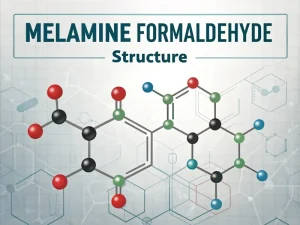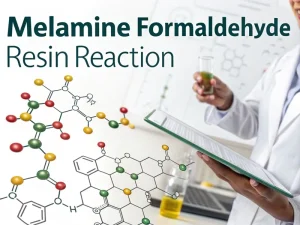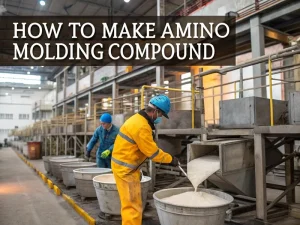
Melamine Formaldehyde Structure
Tech Blog melamine formaldehyde structure Melamine formaldehyde (MF) resin is a high-performance thermosetting polymer known for its excellent heat resistance, durability, and chemical stability. From

Urea formaldehyde resin (UF Resin) is one of the most widely used thermosetting polymers, occupying an important position due to its low cost, multifunctionality, and excellent adhesive properties. The core of various applications, from woodworking adhesives to molded electrical components, relies on the specific molecular structure formed by the precise control reaction between urea and formaldehyde.
A deep understanding of urea formaldehyde structure is key to optimizing its performance, resolving production issues, and expanding application scenarios.
Urea formaldehyde resin is a thermosetting polymer formed by the reaction of urea and formaldehyde. Once heated or chemically cured (hardened), it cannot be melted or reshaped. This characteristic is directly derived from its highly crosslinked three-dimensional molecular structure. It is this structure that makes it an ideal material for adhesives, coatings, and molded products.
The structure formation of urea-formaldehyde resin is divided into two core stages, each corresponding to unique structural features: hydroxymethylation (forming linear intermediates) and condensation/crosslinking (forming three-dimensional networks).
The first stage of urea-formaldehyde resin formation is carried out under alkaline conditions (pH 7-9) and at a medium temperature (60-80℃). At this point, urea reacts with formaldehyde to form hydroxymethylated urea – that is, one or more hydroxymethyl (- CH₂OH) groups are attached to the amino group (- NH₂) of the urea molecule.
This stage is usually carried out under acidic conditions and at high temperatures, and the actual urea-formaldehyde structure begins to form its characteristic network.
Reaction: Hydroxymethyl (- CH₂OH) reacts with unreacted amino groups (- NH₂) on other hydroxymethyl or urea molecules. This reaction releases water molecules (hence the term “condensation reaction”).
Formation of bridges: Methylene bridge (- NH-CH₂- NH-): This is the primary and most stable connection formed when hydroxymethyl reacts with unreacted amino groups. These bridges are crucial for the strength of polymers.
Ether bond (- NH-CH₂-O-CH₂-NH-): When two hydroxymethyl groups react with each other, an ether bond is formed. Ether bonds are usually less stable than methylene bridges and can release formaldehyde under certain conditions.
Three-dimensional network formation: As these reactions proceed, a complex, highly branched, and crosslinked network will form. This rigid network structure determines the thermosetting properties of urea formaldehyde resin.
The final urea formaldehyde structure has the following characteristics:
The unique urea formaldehyde structure directly determines its well-known characteristics:
High rigidity and hardness: The dense three-dimensional crosslinked network restricts molecular motion, making the material very hard.
Excellent heat resistance: As a thermosetting material, covalent crosslinking prevents polymer chains from moving towards each other, maintaining their shape and mechanical properties at high temperatures (up to their decomposition point).
Good chemical resistance: The highly crosslinked structure makes urea formaldehyde resin insoluble in most common solvents and resistant to various chemicals.
Strong adhesion: The polarity of the NH and C=O groups, combined with the ability to form strong covalent bonds with substrates such as cellulose in wood, gives urea-formaldehyde resin excellent adhesion properties.
Brittle: Rigid, highly crosslinked structures lack flexibility, resulting in relatively brittle materials.
Formaldehyde release: This is a crucial issue directly related to the resin structure. Unreacted formaldehyde during the initial synthesis process, or the hydrolysis of unstable ether bonds and unreacted hydroxymethyl groups, can lead to the release of formaldehyde gas over time. Modern urea-formaldehyde resins are designed to minimize formaldehyde emissions.
The structure of urea formaldehyde resin directly determines its scope of application, and the corresponding relationship between structural characteristics and applications is as follows:
The linear prepolymer before curing is water-soluble, making it easy to apply as a liquid adhesive; The crosslinked structure formed after curing can tightly bond with wood fibers, providing strong adhesion. A medium crosslinking density endows the resin with some flexibility, which allows it to adapt to the thermal expansion and contraction of wood. At the same time, methylene bridges ensure long-term bonding stability.
The higher crosslinking density (achieved by increasing the formaldehyde proportion and high-temperature curing) gives the resin greater rigidity and heat resistance. This type of molded product is not easily deformed, and its dense three-dimensional network can block current, providing good insulation performance.
The urea-formaldehyde resin coating relies on a smooth, crosslinked structure to form a hard, scratch-resistant surface. In production, high-temperature curing is used to reduce the proportion of ether bridges and improve water resistance, making it suitable for furniture surfaces or floor laminates.
Low crosslinking density urea-formaldehyde resin is flexible and can be used for textile coating, locking the fiber structure, improving wrinkle resistance, and maintaining the fabric’s extensibility.
The UF resin structure is the fundamental reason it has become an industrial core polymer. By adjusting reaction conditions to control crosslinking density, bridge type, and unreacted groups, manufacturers can customize urea-formaldehyde resins suitable for different applications, such as adhesives, molded products, and coatings.
Understanding the correlation between structure and performance can not only better solve production problems and improve product safety, but also promote innovation in the application of urea-formaldehyde resins. With the increasing demand for low-formaldehyde and high-durability materials, optimizing the structure of urea-formaldehyde resins will continue to help them maintain an important position in modern manufacturing.

Tech Blog melamine formaldehyde structure Melamine formaldehyde (MF) resin is a high-performance thermosetting polymer known for its excellent heat resistance, durability, and chemical stability. From

Tech Blog Melamine Formaldehyde Resin Reaction Melamine formaldehyde (MF) resin is a widely used thermosetting polymer known for its heat resistance, durability, and chemical stability.

Tech Blog How To Make Amino Molding Compound Analysis of Make Amino Molding Compound Formulation In the plastics manufacturing industry, amino molding compounds are a

JINGJIANG MELAMINE POWDER
© JINJIANG MELAMINE